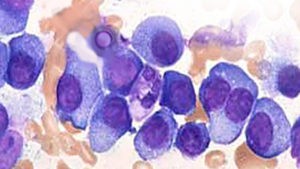
Recently Diagnosed or Relapsed? Stop Looking For a Miracle Cure, and Use Evidence-Based Therapies To Enhance Your Treatment and Prolong Your Remission
Multiple Myeloma an incurable disease, but I have spent the last 25 years in remission using a blend of conventional oncology and evidence-based nutrition, supplementation, and lifestyle therapies from peer-reviewed studies that your oncologist probably hasn't told you about.
Click the orange button to the right to learn more about what you can start doing today.
- You are here:
- Home »
- Blog »
- Multiple Myeloma »
- Multiple Myeloma Treatment- Poor Response to Chemotherapy?
Multiple Myeloma Treatment- Poor Response to Chemotherapy?
“Intensification treatment with CVD significantly improved multiple myeloma PFS… but did not improve overall survival…”
If you’ve been diagnosed with multiple myeloma (MM), your first step will be to undergo induction therapy. Induction therapy is standard-of-care multiple myeloma treatment.
Approximately 75%-80% of MM patients undergoing triplet induction therapy regimens such as RVd can achieve a complete response or very good partial response. According to research, 20%-25% of MM patients undergoing response achieve only a sub-optimal response to induction therapy.
Because conventional oncology generally considers a deeper response to induction therapy to lead to longer overall survival, your oncologist may encourage you to undergo what the studies linked below, call “intensification treatment.”
More chemotherapy will result in more toxicity. More toxicity may result in a lower quality of life and short, long-term and late stage side effects. And, of course, more chemotherapy mens greater expense.
The question for you then, is, what’s in it for me? What is the benefit of intensification treatment?
According to the studies linked below, your choice is pretty clear. Intensification treatment should result in a longer progression-free survival (PFS). This means that your remission will be longer by 10 months in the study.
Unfortunately, you will not realize a longer overall survival (OS). Overall survival is the medical phrase for length of life. Intensification therapy will not help you live longer with your incurable cancer.
But you may very well experience more side effects in the form of
- neutropenia
- thrombocytopenia
- anemia.
To summarize, if you don’t respond to induction therapy as much as you hoped, you can consider intensification therapy (IT). IT, according to research, may result in a longer remission, more side effects, more expense but the same length of life.
Please consider evidence-based therapies but non-toxic therapies shown to fight your MM as well as work with your conventional chemotherapy.
To learn more, scroll down the page, post a question or comment and I will reply to you ASAP.
Thank you,
David Emerson
- MM Survivor
- MM Coach
- Director PeopleBeatingCancer
Recommended Reading:
- Multiple Myeloma Response-CR or VGPR- NO Difference
- Probiotic Prehabilitation for Multiple Myeloma Induction Therapy Improves Outcomes
- Velcade, Myeloma Induction
- Salvage Therapy for Myeloma does not help Progressive Disease..
Response-Adapted Intensification in Multiple Myeloma After Suboptimal Response to Induction
“If a patient with multiple myeloma (MM) experiences a suboptimal response to initial treatment, clinicians may choose to switch to a different agent class with the aim of response intensification, according to study results published The Lancet Haematology.
Researchers assessed response-adapted intensification with cyclophosphamide, bortezomib, and dexamethasone (CVD) compared with no intensification in patients with newly diagnosed MM. They found that some patients may not respond to induction therapy but may benefit from response-adapted intensification…
Patients were randomly assigned to 3 arms:
- induction treatment,
- intensification treatment, and
- maintenance treatment.
All patients were 18 years or older and had symptomatic or nonsecretory, newly diagnosed MM and had achieved partial or minimal response after completing induction therapy with cyclophosphamide, dexamethasone, and thalidomide or lenalidomide. Of the 1217 patients who achieved partial or minimal response, 583 (48%) were assigned to the intensification group.
Patients were stratified by allocated induction treatment, response to induction treatment, and medical center. Primary end points were progression-free (PFS) and overall survival (OS) and were assessed from intensification randomization to data cutoff.
Median PFS was 30 months in the intensification group and 20 months in the maintenance group (hazard ratio [HR], 0.60; P <.0001) after a median follow-up of 29.7 months. The rates of 3-year OS were similar between the intensification and maintenance groups (77.3% vs 78.5%; HR, .098; P =.93).
The most common grade 3 or 4 adverse events in the intensification group were hematologic, with 7% of patients experiencing neutropenia, 7% experiencing thrombocytopenia, and 3% experiencing anemia. In the intensification group, no deaths were determined to be treatment-related.
The researchers concluded that the manageable safety profile of this intensification strategy, as well as the improvement seen in PFS, support further investigation of response-adapted approaches.”
Response-adapted intensification with cyclophosphamide, bortezomib, and dexamethasone versus no intensification in patients with newly diagnosed multiple myeloma …
“Interpretation– Intensification treatment with CVD significantly improved progression-free survival in patients with newly diagnosed multiple myeloma and a suboptimal response to immunomodulatory induction therapy compared with no intensification treatment, but did not improve overall survival.
The manageable safety profile of this combination and the encouraging results support further investigation of response-adapted approaches in this setting. The substantial number of patients not entering this trial randomisation following induction therapy, however, might support the use of combination therapies upfront to maximise response and improve outcomes as is now the standard of care in the UK…”



